
by | | Environment
Inspired by 16-year-old Greta Thernberg’s speech to the UN and the National Garden Club, Inc.’s Conservation Pledge – “I pledge to protect and conserve the natural resources of the planet earth and promise to promote education so we may become caretakers of our air, water, forest, land, and wildlife”, Roswell Garden Club invited high school students from public, private, and home schools in Roswell, GA, to write a blog post exploring how we in Roswell can become caretakers of our air, water, forest, land, and wildlife.
Each year the focus shifted slightly from the first year’s focus on the National Garden Club’s Conservation Pledge. In year two, the focus was on recycling, in year three posts focused on the Chattahoochee River. We invite you to look at the posts on our High School Environmental Blog Posts
We hope you are as inspired by the posts as we are and choose a student’s suggestion and take action on it to help change our world.
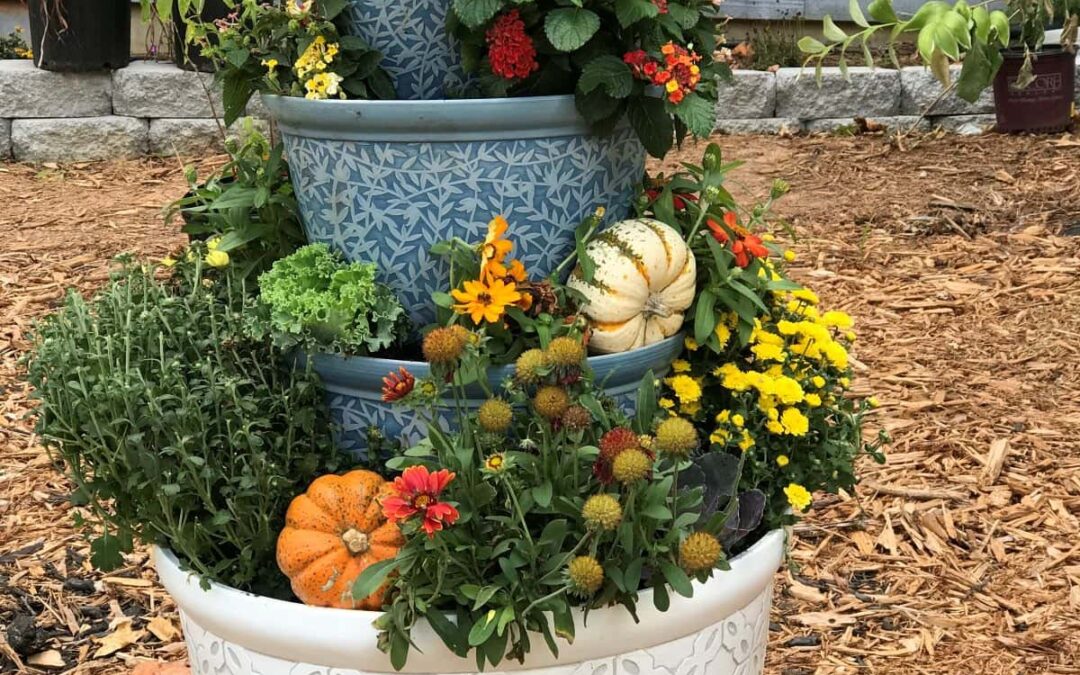
by | | Education, Gardening
Last month’s speaker, Jeanne Singer, inspired me to put together a container project I had been thinking about for some time. It involves a length of rebar or other sturdy thin rod and various sizes of pots with drain holes in the bottom (I used 4), then stacking them on top of each other and putting in plants. You can even stack them topsy turvy at angles for fun. Rebar can be found in various lengths and is inexpensive.
Steps: Find a fairly level spot in your yard or flower bed and hammer the rebar, pipe, etc. into the ground several inches (be careful not to puncture your sprinkler system, cable or utilities) then place your largest container down over it and weigh the bottom with bricks, stones, etc and cover with potting soil and pat down firmly especially in the center, then place the next pot on top but just fill with your potting soil and do the same for how ever many pots you want to use. Then fill with your plants around the open edges. You can have fun with it by placing some themed decorative items around the plants if desired. In the featured image, you can see that, unfortunately, the deer discovered this new salad buffet and sampled some mums before I took the photo.
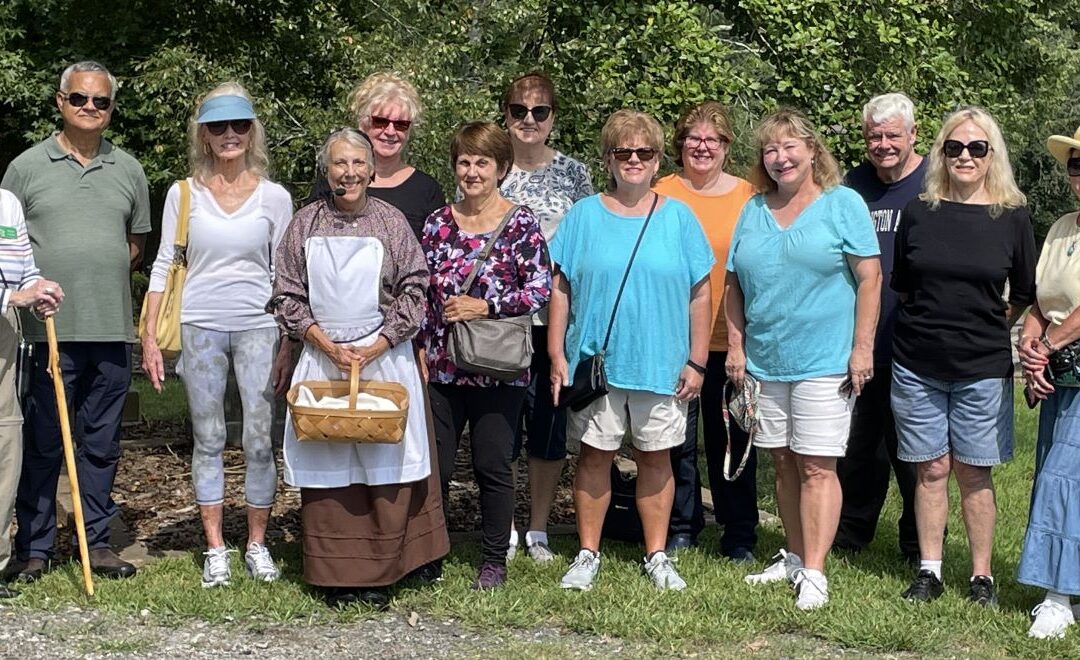
by | | Historic Preservation, Projects
RGC is excited to announce its new partnership with Roswell Historical Society at the Old Roswell Cemetery. We kicked off the partnership on September 6 with a tour led by Janet Jackson, Roswell Historical Society Cemetery Project Coordinator, highlighting history and the landscape elements, trees, plantings, native plants and wildflowers. We are adopting a plot and working with overall clean-up and maintenance of the cemetery.
On September 22, we had a mini work session to get the ball rolling at the cemetery. We were trained on how to groom the heirloom irises. Additional sessions are on Oct. 4, 11, and 18 at 10 am.
Want to get in on the fun? E-mail Florence Anne Berna
Looking for historical bulbs? Brent and Becky’s Bulbs is a great source
Looking for a book about the symbolism of flowers in the Victorian Period? Check out Language of Flowers by Kate Greenway, originally published in 1884, reprinted in 1994
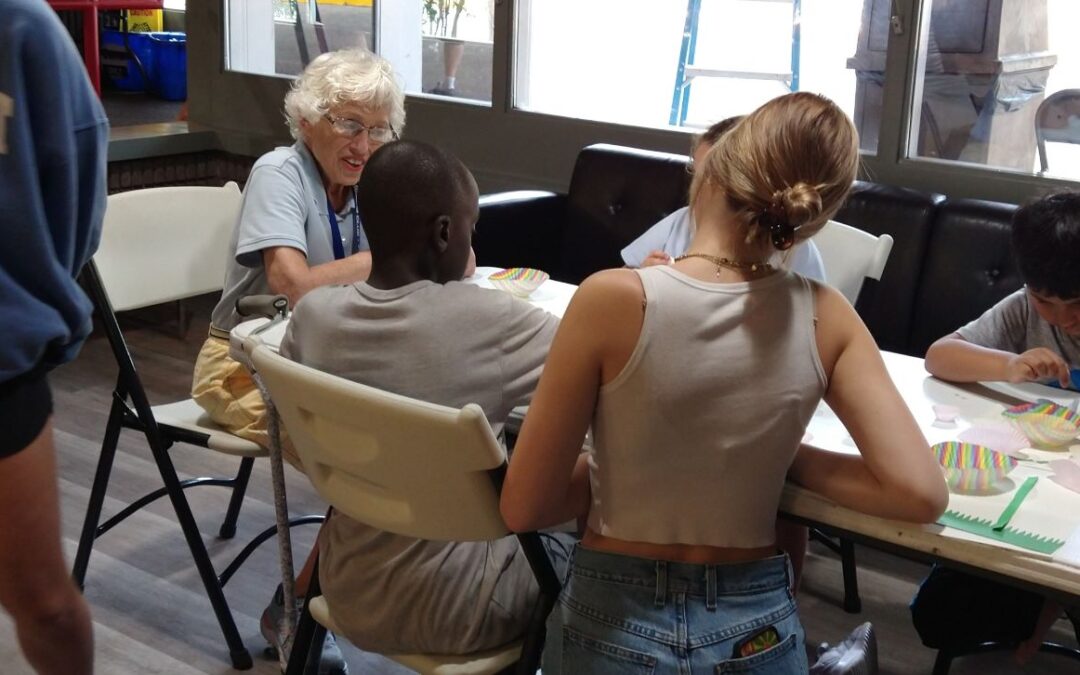
by | | Adaptive Programs, Education, Gardening
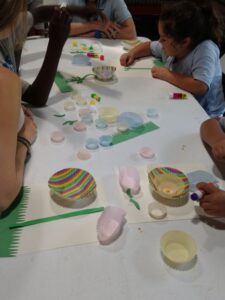 As part of our Adaptive Recreation partnership with Roswell’s ARC, on June 12, several RGC members worked with about 16 children attending the Adaptive Summer Camp at the Waller Park Gym. Three crafts related to gardening and the outdoors were provided: a flower, a rainbow and a butterfly.
As part of our Adaptive Recreation partnership with Roswell’s ARC, on June 12, several RGC members worked with about 16 children attending the Adaptive Summer Camp at the Waller Park Gym. Three crafts related to gardening and the outdoors were provided: a flower, a rainbow and a butterfly.
Crafts included gluing colorful cupcake liners of varying sizes onto a sheet of paper with grass and leaves creating a flower with leaves.
The second activity was making a rainbow mobile. Beforehand, a rainbow design was cut from paper and lines added to create spaces for colors of the rainbow. The children colored these and glued on cotton balls for the clouds. Blue raindrops were attached with string, and a string was attached to the top for hanging. 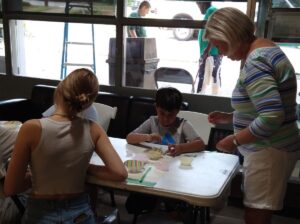
The third activity was a coloring sheet with a large butterfly design.
The children were divided into 3 groups according to the difficulty of the craft and their capabilities. Everyone involved had a wonderful time. Friendship is a hallmark of these activities. We are excited about our ever-increasing partnership with the Roswell ARC and with Roswell’s adaptive programs.
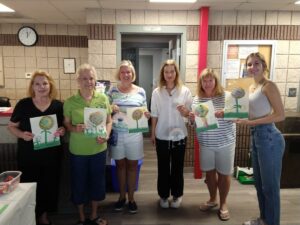
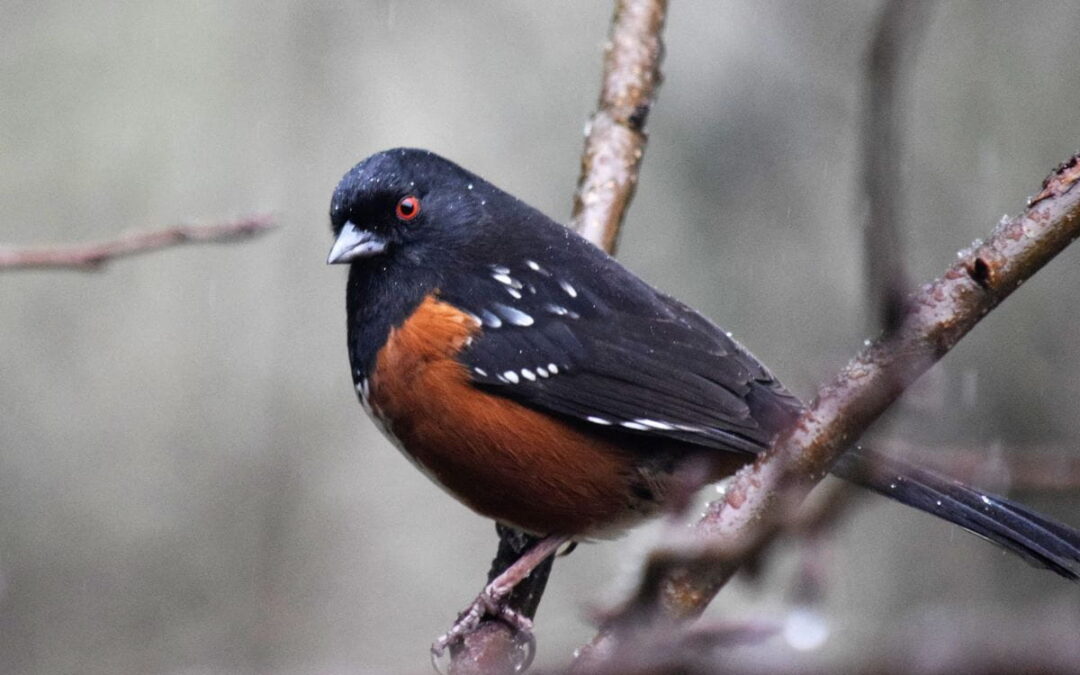
by | | Inspiration, National Garden Week
I was fortunate to have a father that loved nature and would often point out birds and plants to me when I was very young. My first memory of birds (although there probably were others) is of him pointing out the towhee and telling me their name sounds similar to the sound they make. To listen closely and if I heard what sounded like “joree” if would be the towhee singing. I think this is what spurred my interest. All my life I have enjoyed birds and the folklore, myths, and superstitions that surround them – in many cultures and religions. Such beautiful creatures and so fascinating. Towhee photo by Jennifer Uppendahl on Unsplash
Throughout time birds have in general represented “Freedom.” Easy to understand as we watch many of them soar above us. Now we fly in airplanes, but in early cultures this flight of the birds must have truly looked “free” and envious of human’s who were more confined.
Meadow Larks signify joy, hope, laughter/happiness and impending abundance of harvest.
Cardinals symbolize the “hinge” (as a door hinge) between heaven and earth and have become viewed as representing a message from one in heaven. Native Americans believed they were representative of the ancestors.
It is often believed that one will have very bad luck if one harms/kills a sparrow as sparrows hold the souls of the dead. Such a tiny bird and I often wonder why they became associated with the carrier of souls.
Owls in very early cultures often meant wisdom. Later (probably around the Middle Ages) they became known as harbingers of death. Depending on the ancestry of an individual, today both of these still exist but most often they represent wisdom thus “The Wise Old Owl.” It is still strongly believed in superstitions that it is bad luck to see and owl during the day. A lot of different superstitions and folklores revolve around the owl.
It was believed that evil could not dwell within the Dove and they are viewed to represent peace. Such a wonderful belief.
All along the Chattahoochee locally and other rivers, one will often see a Kingfisher (the bird on the logo for Chattahoochee Nature Center). This bird brings good luck.
One bird that has fascinating beliefs associated with it is the Crow. Although it is associated with witchcraft in movies and literature over many years it is truly associated with wisdom. In Native American cultures this bird was considered of high intelligence. They believed the Crow could talk so it had to be wise. In truth, we now know they are great mimics. They have actions for problem solving and therefore they have been shown to be smart birds.
As a child I was fascinated by the beautiful sound of the Whippoorwill (but if you hear a note before the sound “whip-poor will” which makes it sound like “chuck-whip-poor-will” that is the call of the chuck-will’s -widow not the whippoorwill). The whippoorwill, like many birds heard at night, has been associated with death or a bad omen. There was also a belief the whippoorwill could change into small people that roamed through woodlands at night. Superstitions dictated that if a young woman heard a whippoorwill’s call she would still be single a year later. Another superstition says the bird captures the departing souls of the dying (perhaps because the Whippoorwill has a large mouth). So many superstitions and stories surround this bird that is less seen but more often heard. It is not a beautiful bird but has a beautiful sound. That large mouth makes it easy to feed on larger insects that fly at night. Whippoorwill photo by Dieny Portinanni on Unsplash
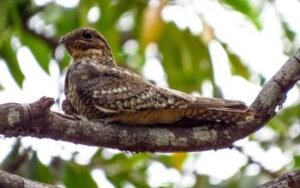
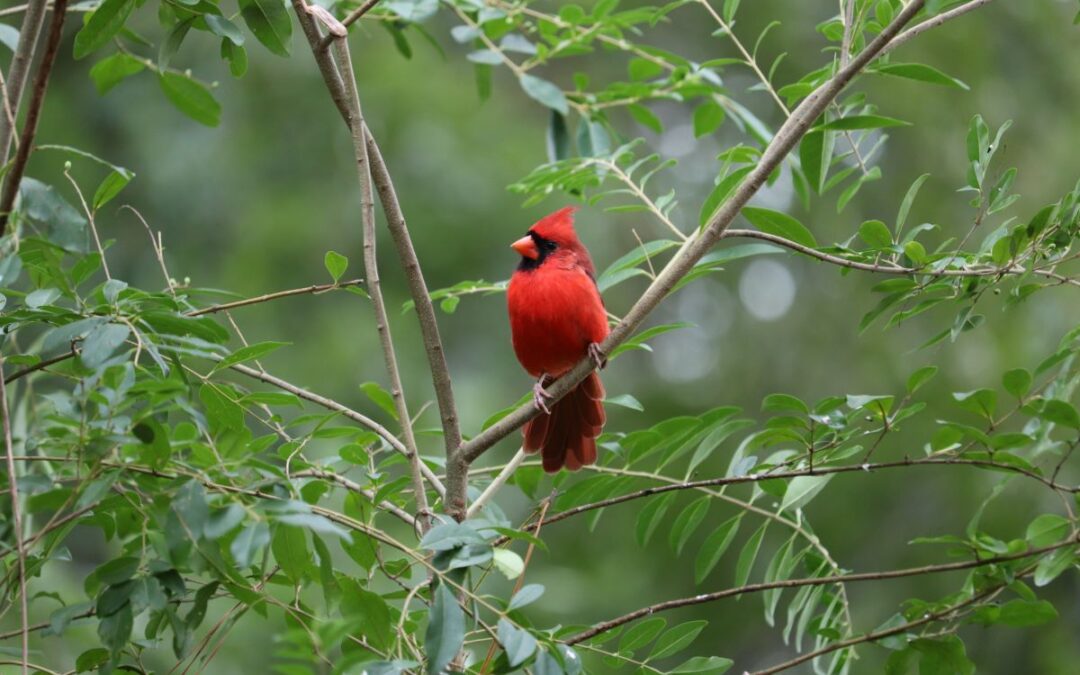
by | | Inspiration, National Garden Week
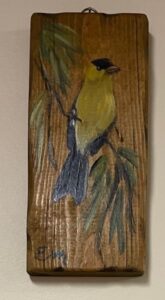 Linda B: I would say my Spark Bird is a Goldfinch. They are not regular customers at my feeders, but as far back as I can remember they always got my attention. I even like them as artwork!
Linda B: I would say my Spark Bird is a Goldfinch. They are not regular customers at my feeders, but as far back as I can remember they always got my attention. I even like them as artwork!
Dawn: I like seeing birds but am not a “birder”. My favorite bird that I’m most fascinated with is the Owl in general with my favorite owl being the white snowy owl, though I’ve never seen one in person. As far as a “spark” bird that makes me happy to see would be the Red Cardinal as I see them at my feeder year round and the Cardinal is that bright spot on a cold dreary and sometimes snowy winter’s day. To me they cause me to think about stamina, strength and determination, hope and family as I often see both a male and female together. And my other favorite is the pretty blue Robin as they signal that Spring is here.
Lisa: “Spark Bird” was a new term to me. It took me some time to decide which bird it was that sparked my interest in birds. In my youth, I was a Camp Fire Girl in Salem, Ohio. I learned the names of birds to earn those precious beads for my vest. However, it wasn’t until I moved to Atlanta that I became interested in the Eastern Blue Bird. It was the first bird I bought a book about. Since then, I listen eagerly to any and all information on birds. I have worked to make my yard bird friendly and strived to plant shrubs and trees that provide a healthy, desirable habitat for them. I am now the proud owner of many bird books and enjoy reading about all species of birds around the world. I’m a pretty bird crazy gal, and it all started with the Eastern blue bird.
Debbie J: My spark bird is Cardinals… It is common folklore that a visit from a cardinal is a sign from a loved one who has passed away. Of course I usually take this with a grain of salt. However I have two stories to tell that may say otherwise.
I have always had many species of birds in my backyard that came daily. Cardinals only came once in a while. In late January 2019 they started to appear more often. Usually a bright red male would bring his family with him. Sometimes additional Cardinals would come also. Everyday the Cardinals would come like clockwork along with a flurry of other bird species. All the birds would take turns eating at the feeder, splashing in the birdbath and sing from the tree tops all day long. I so enjoyed their presence.
Our “Tuxy” cat became ill in February 2019 with colon cancer. Even tho Tux was an indoor cat he loved to go outside and watch the birds while sitting on our stone wall. On April 03, 2019 Tuxy went outside that morning for the last time and went to cat heaven while in my arms. About one hour later after the vet took him for cremation a strange thing happened.
I noticed that it was strangely quiet in my backyard with no birds in sight… no singing… no playing… Nothing. Suddenly a bright red male Cardinal appeared all by himself and sat on our wall directly across from our kitchen picture window. He sat there in a stone like pose for almost 2 hours just staring directly into the large window at me. When he left no other birds visited for another 2 hours. Was this a sign from Tuxy?
Then a similar event recently happened when my husband passed away in October 2021. Shortly after I returned home from the hospice facility that afternoon, once again the lone cardinal came and sat on our wall directly across from the large kitchen window. He only stayed a short time that day but returned late the next morning and stayed a while. He did that everyday for 6 months at various times… just like he knew when I would be in the kitchen to see him. Each time he was the only bird around. Coincidence?
You be the judge. This Cardinal sure made a believer out of me!
The gorgeous photo of a cardinal is by George Berberich on Unsplash
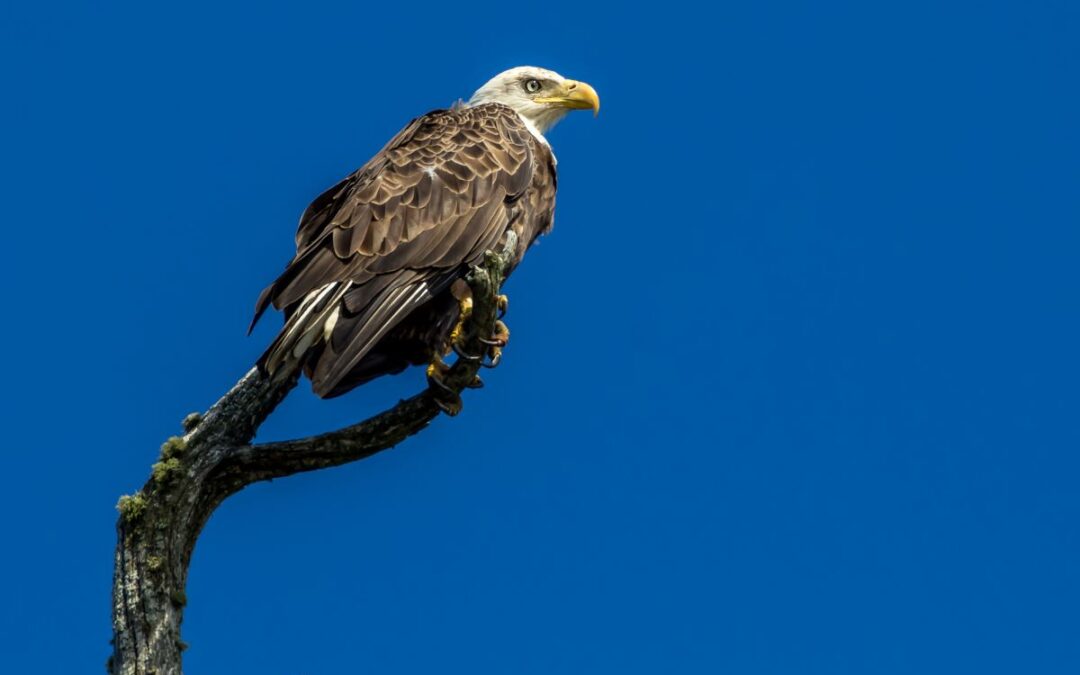
by | | Inspiration, National Garden Week
Gardens and birds go hand in hand, so this National Garden Week we asked RGC members to share their Spark Birds. According to birdwatchinghq.com, “A Spark Bird is defined as the bird that helped spark your interest in birding. It helped open your eyes to the incredible beauty, mystery and excitement of birds and nature. It’s a pivotal moment where your world is changed, and there’s no way you are going back!
A Spark Bird can appear anywhere and be any species. For some, it’s an exotic hummingbird on a Caribbean vacation. For others, it’s a magnificent snowy owl that comes down from the Arctic during winter. For many, it’s a sparrow or songbird that has been ignored for years but finally makes a lasting impression. The stories range from the young to old, from oceans to mountains and from big cities to your bird feeder.”
Here’s what RGC members shared:
King: Not sure if it was really my spark bird because I began reading as a child about birds in the book I still have. But I was fascinated growing up with the mockingbird which would sing at night outside our room, and sing all kinds of songs.
Florence Anne: After thinking it over, my spark bird is the rose breasted grosbeak. One summer when I was 8 years old, our next door neighbors who were wildlife enthusiasts, spotted several in a tree by our yard. I was fascinated by the splash of dark pink on the males. They returned the next year, but then never again. But I never forgot that experience. Gardening has reignited my interest in birding. And I’m always on the lookout for my holy grail, the rose breasted grosbeak.
Donna R: I think my spark bird is the cardinal. My mother always loved them and pointed them out to me as a child. If we saw a male, we would look for the female mate. If we saw the female, we would look for the male. My last 2 homes have had big cedar trees in the yard or nearby and I’ve found that cardinals like to nest in them. It’s not unusual to see multiple pairs nesting in them during the early spring. To this day, I think of my mother whenever I see a cardinal!
Gretchen: This tough fellow (feature image) often lands on a tall tree that overlooks the cove we enjoy at our summer home in New Hampshire. He is one of the stately breed that we admire as a proud symbol of our country, the United States of America. During his summers by our lake he oversees the activity on the lake. He watches the local fishermen, my husband included, and admires their catch.
Additional ‘wild’ residents are a pair of Loons. These water fowl have been banded or tagged by the New Hampshire Loon Society. For this reason we know the male has been with us many years; his mate is a more recent resident who came from a nearby lake….seemingly after his first mate was lost. Each summer we have one or two chicks. As residents of the lake also, we all are fascinated by the chicks as they develop. And, we are not the only observers. The eagles keep a close eye on the chicks. Most of the time we end the summer with two chicks but not always. My husband was fishing from his canoe one evening with a chick in view. He heard the eagle swoop down and saw the chick disappear with him.
But that is nature…we love the frequent presence of the Eagle. And we all are Loon watchers ….enjoying the development of the new family and the haunting songs they give us each evening. As the summer passes we watch the babies develop and finally learn to fly. By October they are ready to leave for their winter on the ocean off the New England Coast. Or, it is possible they spend their winters in the north. Eagles and Loons may possibly stay in the north or migrate to the south.

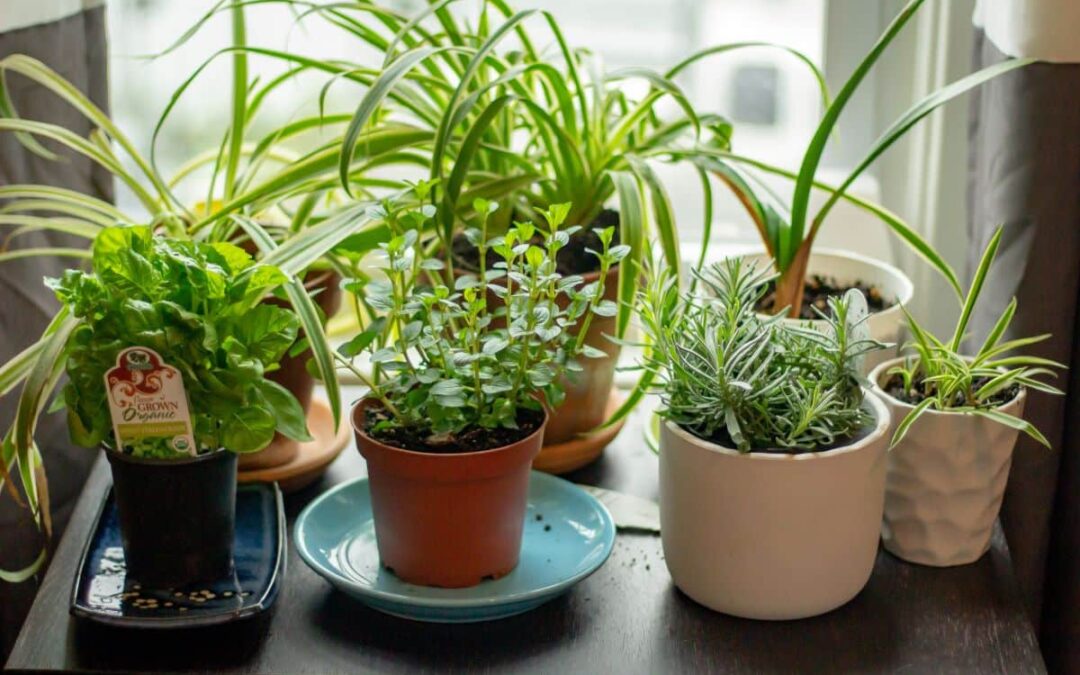
by | | National Garden Week, Plants
Here are some snippets of garden and herb lore for you to enjoy during National Garden Week.
A Bit of Garden Lore: Never thank someone for giving you a plant (or even a cutting from a plant) as it is thought to bring bad luck in growing that plant. It is suggested that the giver should turn their backs which allows the recipient to basically “steal” the plant.
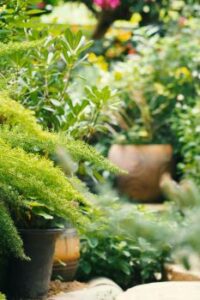 Herb Lore is fun to explore as we grow an herb garden – either an outdoor garden or even pots on a windowsill. If outside, be sure it’s convenient to run grab a cutting when you are cooking…unless you are better at preparing ahead of time than I am. Herbs are fun to grow and to cook with, but they are really ancient and have for centuries had particular beliefs and lore associated with them. Many are used for medicinal purposes, but one should always be careful – just because something is natural does not mean it cannot have some side effects – especially if mixed with traditional medicines. Always check with your doctors before trying any herb for medicinal reasons. Photo by Jade Seok on Unsplash
Herb Lore is fun to explore as we grow an herb garden – either an outdoor garden or even pots on a windowsill. If outside, be sure it’s convenient to run grab a cutting when you are cooking…unless you are better at preparing ahead of time than I am. Herbs are fun to grow and to cook with, but they are really ancient and have for centuries had particular beliefs and lore associated with them. Many are used for medicinal purposes, but one should always be careful – just because something is natural does not mean it cannot have some side effects – especially if mixed with traditional medicines. Always check with your doctors before trying any herb for medicinal reasons. Photo by Jade Seok on Unsplash
If you like to grow herbs, you might enjoy some of the lore that surrounds them:
Nettle: Possibly because it is so very nutritious, this herb is often associated with healing or protection. It supplies protein, calcium, vitamins C & A, magnesium and is high in iron. Superstitions dictated that if eaten in May you would be healthy all year. Nettle leaves can be stirred or crushed, fermented, and used as a fertilizer in the garden. In ancient times it was mixed with eight other herbs in the “Nine Herb Charm” to treat illnesses. The herbs in the charm were Nettle, Chamomile, Thyme, Plantain, Mugwort, Crabapple, Lamb’s Crest, Betony (some believe it was Cockspur), and Fennel. It is said that this “charm” goes back as far as the 10th Century.
Rosemary is a symbol of remembrance and often placed on graves or a sprig in a coffin. It is believed that inhaling Rosemary increases cognitive functions. If you insert this herb in a bouquet (or gift) you are giving to someone, it is thought to bring good luck and that they will remember the friendship. It can be used in closets to deter moths.
Sage: This is a fascinating herb. When mixed with Thyme, Lavender and Rosemary in a vinegar base, this herb was used as a defense against the plague. Smudging with Sage is said to cleanse the house or room and free it of bad spirits or negativity. There is a specific way to smudge so read up on this if you decide to do it.
Bay Laurel (Bay Leaves) keep evil from the home. You will often find it grown in containers, shaped as topiary, and placed on each side of the entrance to homes. This holds true today although they probably use them at the entrance because they are just really pretty and they do hold their shapes nicely.
Lavender is cherished for its aroma and said to induce calm and to help lull one to sleep. If Lavender is grown in a garden it is said to bring good luck. Because of the wonderful fragrance, this herb has been popular for an exceptionally long time. In early Egypt, it was used in in embalming and the mummification process. Even today it is used in soaps, shampoos, teas, cooking, and many other ways. Lavender really is a beautiful herb to grow and to use.
Chives were hung in doorways to ward off evil spirits and disease. Chives were also used in fortune telling. Today planting chives in the garden is said to help ward off pests.
Herbs and potions were often associated with witchcraft, but it was said that Dill would keep the witches away.
Sprigs of Fennel deter flies and when placed in keyholes it is believed to keep ghosts away. Fennel is said to aid in digestion and helps control the appetite.
Thyme comes from the Greek language and means “to fumigate or smoke.” It is often used in incense burners today as well as through the ages. It has a nice fragrance to it, and its blooms are known to attract bees. Since bees were often thought to carry messages to the fairies in some cultures, the legend grew that fairies lived in thyme patches. When thyme was burned or its oil applied to the body, it was believed to give one courage. Young women often sent thyme with their warriors going to battle. It has also been used as an antiseptic.
It’s fascinating to study garden and herb lore. The study opens a window into gardening in history. The featured image for this post is by Bonnie Kittle on Unsplash.
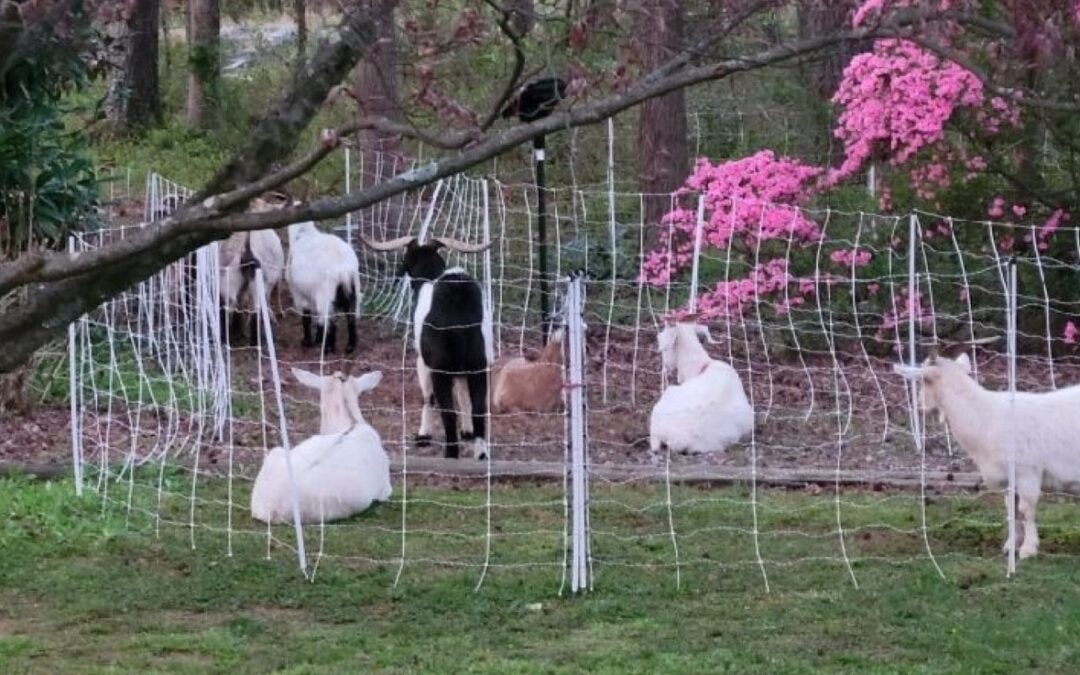
by | | Environment, Gardening, National Garden Week, Plants
In the Spring of 2022 my husband and I realized that we could not tackle the tangled mess that is the rear of our 1+ acre lot. So instead we decided to engage goats to work on the English ivy, wild grapevine, honeysuckle, Virginia creeper, and privet in the under story of our oak, walnut, magnolia, sassafras, mimosa, and sweetgum wooded lot.
Mansell Landscaping (Arnold Mill Road, Woodstock) to the rescue! They have diversified their services to include a herd of goats which they rent out for just this work. We loved the idea of using a local company, especially with an old Roswell family name.
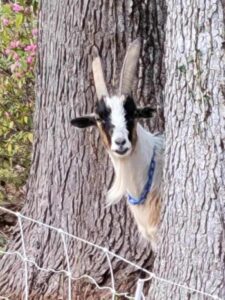 Barry and Joy Mansell showed up with a trailer full of 10 hungry goats ready to munch away. They stayed with us for seven days and nights enjoying a smorgasbord of greenery. Their bleating greeted us each morning as the sun rose to wake them from their night’s sleep bedded down under the trees.
Barry and Joy Mansell showed up with a trailer full of 10 hungry goats ready to munch away. They stayed with us for seven days and nights enjoying a smorgasbord of greenery. Their bleating greeted us each morning as the sun rose to wake them from their night’s sleep bedded down under the trees.
The goats were all different breeds so they looked different and had a variety of 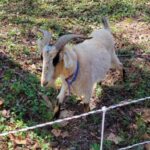 personalities. They were very social and all had names. They did a super job cleaning up George’s raised garden beds, making them ready for turning and planting this year’s vegetables.
personalities. They were very social and all had names. They did a super job cleaning up George’s raised garden beds, making them ready for turning and planting this year’s vegetables.
Their routine seemed to be eating for an hour and a half, take a nap, and eat again. A pop-up tent was provided for them to huddle under when it rained and we put out tubs of water for them. They were enclosed by a portable electric fence so they were right where we wanted them.
They were fun to watch and – bonus – goat poop has no odor and is an excellent fertilizer. Win, win!
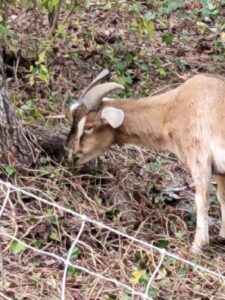
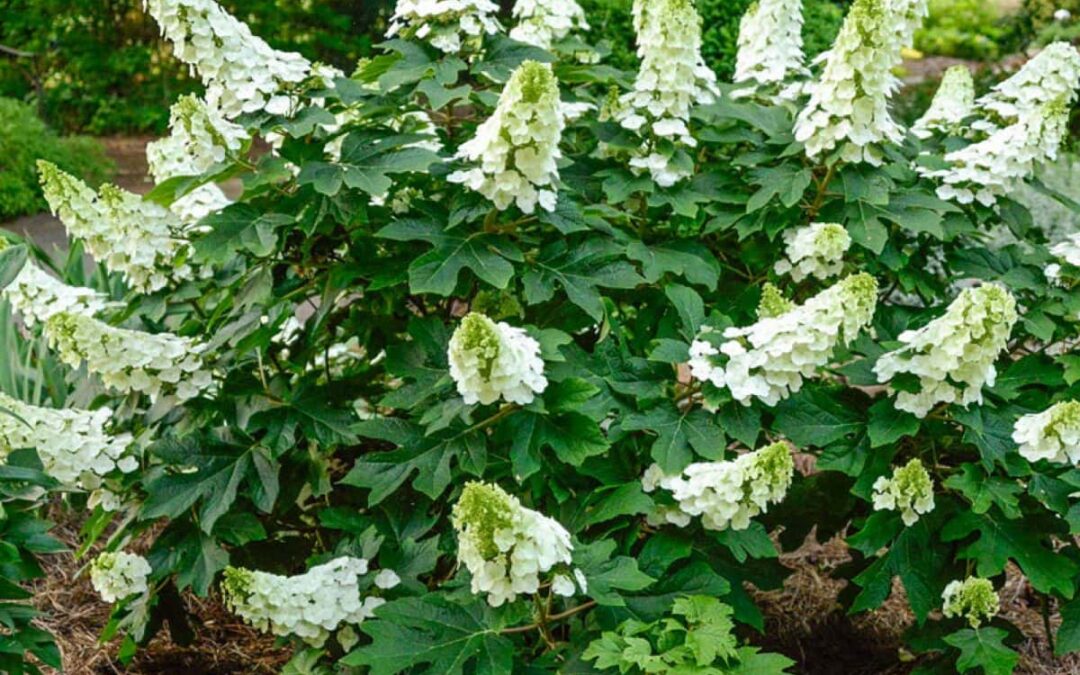
by | | Gardening, Horticulture, National Garden Week, Plants
Ahhh!!! Spring and early summer! The time of year that stirs our mind, spirit and body into venturing outdoors and communing with nature. So you rise up, arm yourself with tools and head out to tackle the weeds, pruning and edging. After all of the ‘grunt’ work is done you head to the stores to buy your beloved summer plants. Buying plants that have been pampered in greenhouses to look their very best to entice you to buy them. At home, you follow all the rules for Southern gardening: Till the clay. Amend your soil with sand and peat moss. Mix in some all-purpose fertilizer. Plant your summer selections and water. Then the heat comes and quite possibly a drought. Or perhaps too much rain. In no time at all those lovely summer plants are not well or worse — not even alive! There is an alternative. All one has to do is look back into the history of southern gardening. The answer is southern heirloom plants. Heirloom plants are those plants that were most commonly cultivated in southern gardens many generations ago. They are still around today because they are fool proof. They have survived countless summers of heat, drought, poor soil and in many cases great neglect. Many heirloom plants provide great color and fragrance, too. With just a little research on your part you can make a better investment in your landscape and save yourself some work in the process. Heirlooms are generally low-maintenance and disease-resistant. They would have to be to survive throughout the ages!
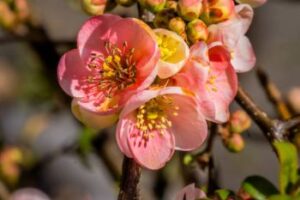 Just keep in mind the following plant categories when planning your heirloom garden: Ephemerals are those plants that will literally disappear into the ground by fall or early winter, The placement of these plants or bulbs will need to be marked so you can remember where they are. Deciduous plants will remain visible in your garden throughout the year but will lose their foliage in the winter.
Just keep in mind the following plant categories when planning your heirloom garden: Ephemerals are those plants that will literally disappear into the ground by fall or early winter, The placement of these plants or bulbs will need to be marked so you can remember where they are. Deciduous plants will remain visible in your garden throughout the year but will lose their foliage in the winter.
Roswell Garden Club has researched local historic plants. and here are some examples of heirloom plants that have lived and thrived in Roswell for more than 150 years. In the Ephemeral category there arc Lilies of the Valley, Star of Bethlehem, Spanish Blue Bells, Grape Hyacinth, Tiger Lilies, Iris, Blackberry Lilies. Jonquils and Violets. Deciduous specimens include Bridal Wreath, Mock Orange, Oakleaf Hydrangea, Dogwood, Flowering Quince, Wisteria, and Flowering Almond. Evergreen plants providing an all-season interest in the garden are Southern Magnolia, Spanish Bayonet (Yucca), Gardenia, Camellia, Mahonia and Boxwood.
These plants have all been identified as being on historic properties in Roswell. Many are available at local specialty nurseries or through area plant societies. Many of these clubs having plant sales in the spring and fall, along with garden tours this time of year which is an excellent source for purchasing these varieties. At these events you can ask the experts about the plant to confirm its exact growing conditions and eventual size. Best of all-they were most likely propagated from local heirloom plants so they come from very good, reliable stock!
If you would like to see many of these plants in action, treat yourself to tours of the various historic homes in Roswell that are open to the public. All have period gardens and plants for you to inspect and enjoy.
For those of you hungry for more knowledge-join a garden club. The Roswell Garden Club meets monthly from September to May and is involved in many community garden projects. As members participate and work on these projects, they learn many aspects of Southern gardening and can apply this knowledge to their own gardens. Plus it’s great fun to network with other garden enthusiasts. In the meantime, start incorporating heirloom plants in your garden. While you’re saving time, energy and money, you will be creating your own legends.





 As part of our Adaptive Recreation partnership with Roswell’s ARC, on June 12, several RGC members worked with about 16 children attending the Adaptive Summer Camp at the Waller Park Gym. Three crafts related to gardening and the outdoors were provided: a flower, a rainbow and a butterfly.
As part of our Adaptive Recreation partnership with Roswell’s ARC, on June 12, several RGC members worked with about 16 children attending the Adaptive Summer Camp at the Waller Park Gym. Three crafts related to gardening and the outdoors were provided: a flower, a rainbow and a butterfly.




 Linda B:
Linda B:


 Herb Lore
Herb Lore
 Barry and Joy Mansell showed up with a trailer full of 10 hungry goats ready to munch away. They stayed with us for seven days and nights enjoying a smorgasbord of greenery. Their bleating greeted us each morning as the sun rose to wake them from their night’s sleep bedded down under the trees.
Barry and Joy Mansell showed up with a trailer full of 10 hungry goats ready to munch away. They stayed with us for seven days and nights enjoying a smorgasbord of greenery. Their bleating greeted us each morning as the sun rose to wake them from their night’s sleep bedded down under the trees. personalities. They were very social and all had names. They did a super job cleaning up George’s raised garden beds, making them ready for turning and planting this year’s vegetables.
personalities. They were very social and all had names. They did a super job cleaning up George’s raised garden beds, making them ready for turning and planting this year’s vegetables. 

 Just keep in mind the following plant categories when planning your heirloom garden:
Just keep in mind the following plant categories when planning your heirloom garden: